I think most of us would agree that the world can still often be a dangerous place. While radical leaders and warlords have always resorted to intimidation and violence to achieve political or religious objectives, the emergence of a new kind of ruthless and unconventional enemy has transformed not only some aspects of our daily lives, but also how we engage this enemy in battle.
In response, tactics and weapons have been developed to give those taking part in these fights a decisive advantage, and the capability to overwhelm and quickly neutralize even the most hostile threat.
The M134D Minigun, manufactured by Dillon Aero Inc. (DAI) of Scottsdale, Ariz., is one such weapon. And, it brings a definitive and game-changing advantage to the fight.
The DAI M134D is an electrically powered, six-barrel Gatling gun that chambers the 7.62-mm NATO rifle cartridge. In its standard configuration, the six rotating barrels fire a total of 3,000 rounds a minute. But, the gun can also be geared to fire 4,000 rounds a minute — all with virtually no recoil.
Considered a premier weapons system, the M134D is highly regarded in the special operations community. Few weapons match its extraordinary firepower and paralyzing effect on the enemy; plus, its relatively small size makes it ideally suited for helicopter applications.
Surprisingly, the existence of the M134D is one of happenstance. About 20 years ago, the original version of this weapons system was literally on the verge of extinction in modern military arsenals. But, one man, largely pursuing his own personal hobby, inadvertently saved it — and then built an entire company around it.
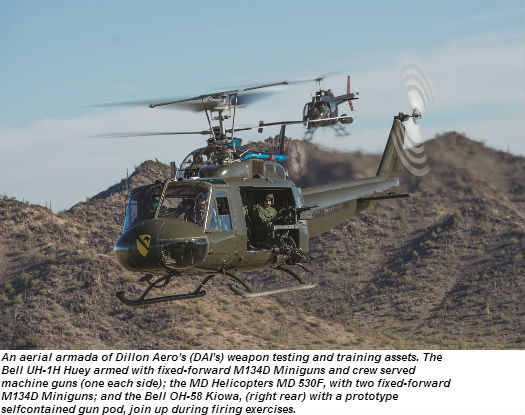
Practical Beginnings
In the early 1960s, when the United States was spooling up its involvement in Vietnam, the U.S. military recognized the need to defend its increasing number of otherwise-vulnerable helicopters from enemy ground fire. It sought a weapons system suitable for helicopter installations that could produce an extremely high rate of concentrated fire. By scaling down its M61 Vulcan 20-mm gun/cannon, General Electric (GE) was able to respond with the 7.62-mm Minigun, known more commonly as the M134 for its U.S. Army designation.
By the early 1970s, U.S. forces in Southeast Asia had taken delivery of an estimated 10,000 GE Miniguns. They were used on a variety of platforms, but primarily saw installation on fixed- and rotary-wing aircraft, including the Douglas AC-47 Spooky; Fairchild AC-19G Shadow; Bell UH-1 Huey, OH-58 Kiowa and AH-1 Cobra; Hughes OH-6 Cayuse; and Sikorsky HH-53 Super Jolly Green Giant.
The M134 was a menacing force, but it wasn’t without its problems. Design flaws soon became evident and wear to the internal components greatly affected reliability.
Worse, with U.S. involvement in the Vietnam War winding down, in the mid-1970s GE decided to discontinue support for the Minigun. Within about 10 years, spare parts became scarce. And, by the early 1990s the small handful of military units that still utilized the M134, including the U.S Army’s 160th Special Operations Aviation Regiment (SOAR), found it increasingly difficult to maintain their weapons.
Known as the “Night Stalkers,” the 160th SOAR is an elite regiment that operates a mixed fleet of helicopters (Sikorsky MH-60 Black Hawks, Boeing MH-47 Chinooks, and Boeing and MD AH/MH-6 Little Birds) supporting a wide variety of combat missions that often take place at night. The M134 was an invaluable weapon for this unit, but spares and serviceability placed the gun on the short list for removal from inventory.
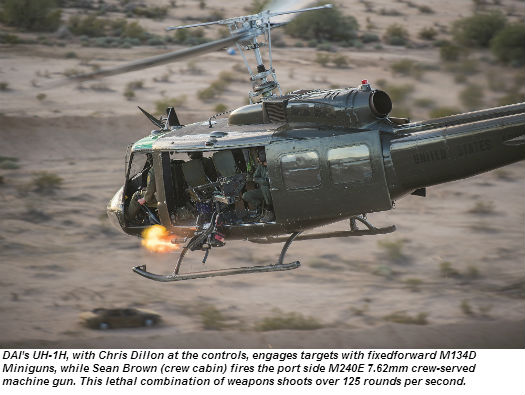
An Accidental Savior
Around the same time the 160th was dealing with its M134 problems, Mike Dillon had become interested in this weapons system.
While Mike has a long history in aviation — flying everything from jets, to crop-dusters, to warbirds, to helicopters — he also has a love of firearms. A couple of decades earlier, that interest, combined with his fix/build-it-yourself attitude, led to the creation of Dillon Precision Products (DPP), an ammunition-reloading products company.
The success of DPP gave Mike the freedom and resources to pursue his many personal interests. One of those was a desire to expand his experience in firearms: beyond the traditional sporting variety to more exotic models.
In the late-1980s, one of those models happened to be the M134. After purchasing a number of surplus Miniguns, Mike discovered the guns were often unreliable and incapable of maintaining sustained fire. Undaunted, he decided to tear into the Minigun’s inner-workings to determine the cause of the problems. While it turned out that the major concern was that the surplus guns were simply worn out, Mike did also identify the Minigun’s feeder/de-linker as a design weak point and decided to do something about it.
As his youngest son, Chris, now vice-president of DAI, explained: “The feeder/de-linker is a component of the gun that takes linked ammunition out of a magazine, separates and discards the link, then takes the cartridge and feeds it into the gun’s bolts. It does that process 50 times every second.”
Calling on his experience as a machinist, Mike set about revamping the feeder/de-linker, thus producing the first major component redesign of the Minigun, greatly improving the weapon’s reliability. He also made modifications that enabled a gunner to quickly and easily address a jam or malfunction in the Minigun.
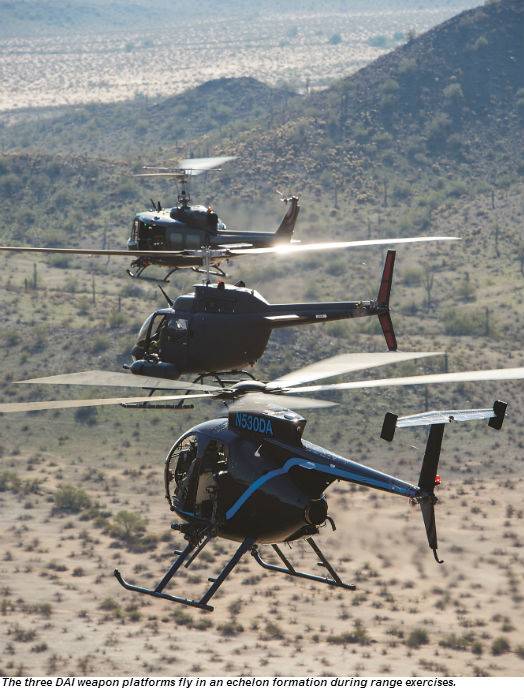
Through happenstance, the 160th SOAR caught wind of Mike’s innovations. Intrigued by the prospect of breathing new life into its aging inventory of M134s, the unit invited the Dillons to Fort Campbell, Ky., to conduct a demonstration.
The Army was so impressed that Chris said it soon ordered some 600 new feeder/de-linkers to retrofit its inventory. DPP and its pool of vendors and machinists were recruited and DAI was later created to take on this unexpected volume of work.
That success inspired Mike to pursue other Minigun improvements. Over the next few years, a number of components were redesigned, including barrels, bolts, feed systems and ammo cans. This sparked interest from the U.S. Air Force, which soon ordered thousands of DAI’s re-engineered bolts.
Eventually, Chris said almost the entire Minigun was revamped: “Item by item by item, we corrected deficiencies in the system, and by 2002/03 we had effectively built an entirely new gun.” Then, the company finally did redesign and start producing a whole new M134.
Today, DAI’s 55 employees, who are at the heart of the company’s operation, produce and support a new generation of Miniguns — the standard M134D, the lightweight (titanium) M134D-T and the hybrid (titanium-steel) M134D-H — along with a variety of components. Plus, to improve utilization of the Minigun, DAI is expanding its product line to include items such as specialized gun mounts and ammunition feed systems.
And, with operators around the world looking to adapt the M134D line to fit a wider variety of platforms, including wheeled vehicles and naval vessels, DAI has created a fabrication shop staffed by four talented fabricator/machinists, led by Mike Leavitt. This team designs, rapid prototypes and produces highly specialized gun turret installations, including retractable versions, for everything from armored SUVs, to military Humvees, to jungle-based hovercrafts. When necessary, parts of the team can even be sent anywhere in the world to support urgent or logistically challenging situations.
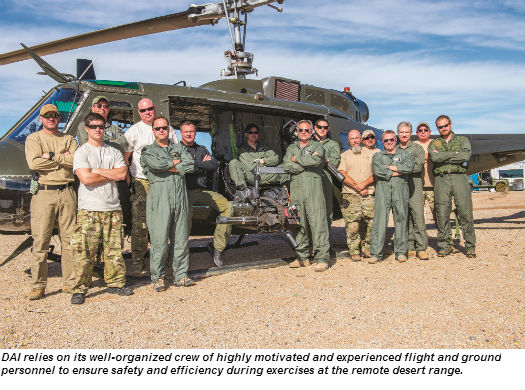
Flight-Testing the Guns
Even with the growth in non-aerial applications, rotary-wing platforms remain at the core of the M134D’s installations. As such, the core of DAI’s research and development continues to revolve around its three test helicopters — a UH-1H Huey, an OH-58 Kiowa and an MD 530F.
“From day one, since we began to arm the helicopters with Miniguns, their primary role has been R&D,” said VP of operations, Greg Aguirre.
“Having our own airframes enhances our effort, allowing our technicians to accurately make measurements or identify internal aircraft support structures for engineering needs. They also enable us to submit projects and product improvements to demanding, realistic, operational testing.”
To that end, the UH-1H can be configured with two pilot-fired, fixedforward M134Ds, one on either side of the aircraft. Additional mounts can accommodate a third and fourth M134D (or a variety of other weapons systems, such as the M240 or Russian PKM machine gun) to provide crew-served or flex-fire stations.
The OH-58, meanwhile, is currently configured as a testing platform for an innovative, self-contained Minigun system housed in a single, externally mounted pod.
As former military aircraft, the Huey and Kiowa are classified as experimental. Their operation, arming and maintenance are all performed in accordance with the original military manuals.
The MD 530F, however, is a civil aircraft, and only has a few modifications to accommodate its two fixed-forward Miniguns. This helicopter is often utilized for training and is configured with an innovative, headsup- style gun sight that helps inexperienced pilots quickly learn how to become instinctive point-shooters (a skill Little Bird pilots require in combat).

When the MD 530F has the Miniguns mounted, the U.S. Federal Aviation Administration classifies the guns as Class A external loads, meaning the helicopter must be operated under an FAA Part 133 certificate. When unarmed, the aircraft is operated under Part 91.
Typically, 3,000-round magazines are used for helicopter installations. Mounted in the rear cabin, they connect to the guns via feed chutes. The exception is the self-contained gun pod, which has an integrated, internal ammunition magazine.
A stock Bell 407 rounds out the DAI fleet, but it’s strictly a peoplemover, transporting customers and VIPs between headquarters and the remote shooting ranges. Purchased new in 2006, it’s equipped with an autopilot, leather seating, Chelton electronic flight instrument system, and, given Arizona’s climate, ample air conditioning.
The People and the Place
At the center of everything is Dillon Aero’s headquarters at the Scottsdale Airport; space it shares with Dillon Precision. In addition to offices and production facilities for both companies, DAI has a spacious hangar to house and maintain its helicopters and its Pilatus PC-7 fixed-wing trainer.
Reflecting back on the evolution of DPP (now headed by Mike’s oldest son Steve), and the serendipitous creation of DAI, Chris stated: “We’re a bunch of guys who like guns, grew up shooting guns, making things with our hands and we grew up flying airplanes and/or helicopters. It just so happens we found ourselves in a business that needed that set of skills. Without any one of those skills, none of this would have happened.”
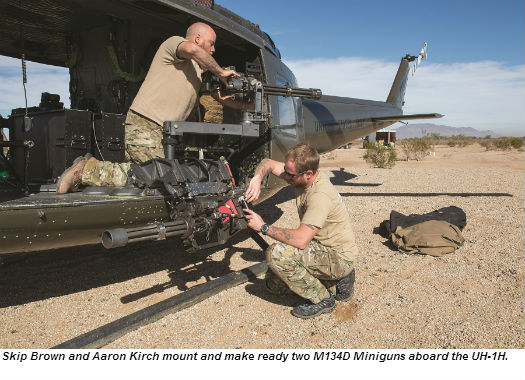
That serendipity has touched the lives of many people — and it gave this reporter a chance to not only meet this fascinating group, but also fire the legendary Minigun!
Firing the crew-served M134D from a helicopter is surprisingly instinctual. Standing in the doorway clutching the grips, the gun feels perfectly balanced, seemingly floating weightless on the mount. Acquiring and following targets is effortless. The grips position the shooter’s thumbs over two buttons on the gun control unit. Once the gun is switched “on,” lightly depressing either button lets rip a growling burst of remarkably accurate fire.
Accurately targeting with the fixed-forward guns is the responsibility of the pilot and requires a unique skill set. As Nick Perfetto, DAI’s international business development manager and one of its demonstration/instructor pilots, told me, the aircraft must be precisely maneuvered to align the guns to the target.
Since the Miniguns are only as effective as the crews utilizing them, DAI is committed to evolving and improving its training curriculum. It offers gunner and armorer (maintainer) courses for its military customers, covering all aspects of operating, shooting and maintaining the M134D.
And whether testing or training, when the aircraft return to the hangar, the maintenance crews take over. Due to the unique function of these helicopters, the crews always start their efforts with a thorough wipe-down of each ship. Said Al Christmas, DAI’s director of aircraft maintenance, “With the [thousands] of brass [casings] and links coming out of the aircraft . . . . we [have to] wipe to ensure we can pick up any nicks or dents.”

This attention to detail is not surprising, considering many DAI employees have years of military service, including combat deployments in Vietnam, Iraq and Afghanistan, where helicopters and Miniguns played a significant role in their battlefield experiences.
It’s also not surprising that everyone here embodies their own individual measure of commitment; each employee knows the lives of men and women in uniform literally depend on how well they each perform their jobs.
However, this dedication to the customer extends beyond just military units utilizing the M134Ds, as DAI will employ any number of company assets to support the specialized mission and training needs of most any military or civil-law-enforcement unit.
“The sense of support of first responders, law enforcement and the military is off the charts around here,” said VP of operations Aguirre. “Knowing that we are in a position to contribute to their efforts is reward in itself; and, that sense of service is present in every [Dillon Aero] employee.”





